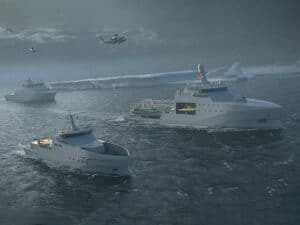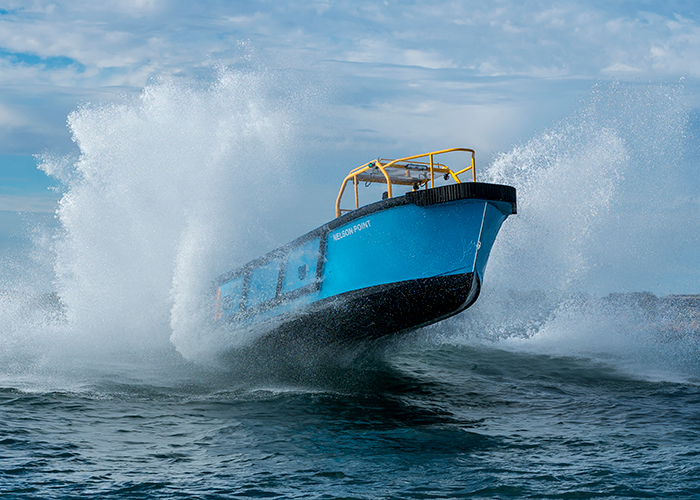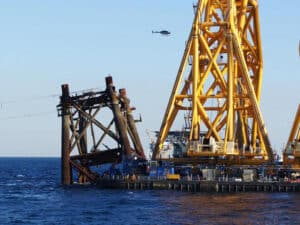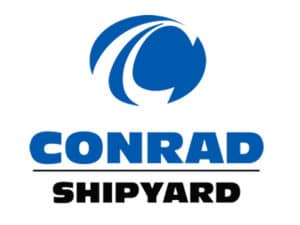
VIDEO: Fast and versatile workboat joins Jetwave fleet
Written by Nick Blenkey
On trials, the boat demonstrated 1.2 tonnes of bollard pull as well as loaded speeds of 29 knots at full power.
Now at work in Port Hedland, Western Australia, the 9.8-meter aluminum workboat Jetwave Nelson Point is the latest addition to the fleet of around 30 specialized vessels operated by Jetwave Marine to serve clients in the oil & gas and resource industries Australia-wide.
The vessel is the second custom workboat built for Jetwave by Western Australia boatbuilder Dongara Marine.
Designed by Southerly Designs, the boat can perform a variety of harbor services tasks including line handling, crew/personnel transfer, and survey operations.
For the primary lines boat task, Dongara Marine has fitted the vessel with a towing crucifix rated at up to 2.5 tonnes. The two crew sit forward of this in a covered protective cage with a mesh guard aft shielding against potential lines snap back. The attention paid to minimizing the chance of lines getting caught is reflected across the boat in details such as bollards recessed within the bulwarks.
To facilitate crew/personnel transfer operations, fold-down seats for six passengers are integrated into the bulwarks. In addition to handling lines, the flush aft deck with open transom enables up to 2.2 tonnes of deck cargo to be carried.
WATERJET PROPULSION
As with the previous vessel the propulsion package consists of a single 272 kW Yanmar diesel, Twin Disc gearbox, and an HJ322 HamiltonJet waterjet seleced for its combination of towing power, cavitation resistance, and high-speed performance.
On trials, the boat demonstrated 1.2 tonnes of bollard pull as well as loaded speeds of 29 knots at full power and 26 knots at 85 per cent MCR. Fuel consumption is less than three liters per nautical mile, and the boat has a 600 liter fuel tank.
While high speed is unusual for a lines boat, Jetwave Marine’s Operations Manager, Mick Warren, says it is an added benefit that also has operational advantages.
“We don’t often use the speed, because mostly we are handling lines,” he says. “For us, the advantages of using waterjet propulsion in that role are the enhanced maneuvering, directional thrust, and avoiding having an exposed propeller with consequent entanglement risks.” he said.
“The speed is really a bonus, and it’s certainly good to have when we need to move between jobs quickly, and when transferring personnel,” he adds.
To help optimize machinery operating conditions in Port Hedland’s often extreme temperatures, Jetwave Nelson Point is fitted with a full engine room ventilation system provided by Marine Air Flow. This includes mist eliminator grilles, outlet grilles, D.C. compact fans and air dampers.
Jetwave Marine ordered the vessel in October 2019, five months after taking delivery of its first newbuild from Dongara Marine. That boat, Jetwave Stanley Point, has been successfully working as a lines boat / personnel transfer vessel in Port Hedland since May 2019.
“With Jetwave Stanley Point we certainly wanted something a little bit different, and Dongara Marine delivered exactly what we asked for,” says Warren. “It has proved to work really well in service, and we are really happy with it. In fact one of our skippers says it’s one of the best boats he has ever driven.
“Whenever you buy another boat you look for improvements, and I know that [Dongara Marine Managing Director] Rohan Warr takes the same approach as a boatbuilder,” Warren notes.
One change in the latest boat is to the fendering arrangement.
“We’ve got a bit less on the bow of this vessel, and we’ve added some on the sides, just to reduce wear and tear on the paintwork and aluminum structure,” Warren says.
The new lines boat also has more traditional bow and finer forward sections than its predecessor.
“For the first boat we requested the fuller bow shape, and Southerly Designs and Dongara Marine were happy to accommodate that. For this boat we have gone for the more typical Southerly bow shape, one that I am familiar with having grown up in the Mid West,” Warren
Rohan Warr notes that the more traditional bow makes for a more versatile platform.
“As Jetwave Marine’s experience has shown, either bow shape will work well in the conditions typically experienced in Port Hedland’s inner harbor. The advantage of the finer bow entry is that it provides flexibility to work in harsher sea conditions, and we certainly demonstrated its ability in waves during trials off the coast,” says Dongara’s Rohan Warr. “That may prove beneficial for Jetwave Marine in the future in terms of use in other ports or roles. It also makes it a great basis platform for a wide range of coastal work boat applications including aquaculture support, as a small passenger boat, for commercial or recreational fishing, in security roles, or even as a fun recreational craft.”
Specifications
- Name of vessel: Jetwave Nelson Point
- Type of vessel Lines / work boat
- Survey Australian Maritime Safety Authority (AMSA) – National Standard for Commercial Vessels (NSCV) Class 2D
- Port Port Hedland, Western Australia
- Date of delivery May 2020
- Owner / operator Jetwave Marine
- Designer Southerly Designs
- Builder Dongara Marine
- Construction materials Aluminum hull and deck
- Length overall 9.8 meters
- Beam 3.2 meters
- Draft 0.4 meters
- Main engines Yanmar 6LY2A-UTP. 272kW (370hp)
- Gearboxes Twin Disc
- Propulsion HamiltonJet HJ322 waterjet
- Maximum speed 29 knots (loaded, 100% MCR)
- Cruising speed 26 knots (loaded, 85% MCR)
- Fuel capacity 600 liters
- Fuel consumption 80 liters per hour at 27 knots
- Electronics supplied by Geraldton Marine Electronics
- Plotter HDS Live 7
- Radios Icom VHF and Simrad VHF/AIS
- Paints/coatings Jotun Xtreme Gloss. Painting by Dongara Marine
- Lighting Ultra Vision flood lights
- Bollard pull 1.2 tonnes
- Deck cargo 2.2 tonnes
- Crew 2
- Passengers 6
- Trailer Duralite Trailers, 8.5 tonnes




